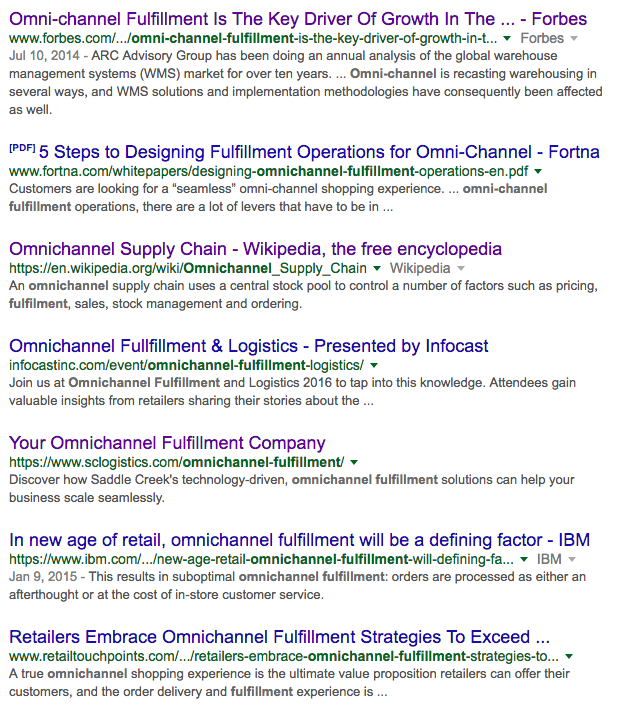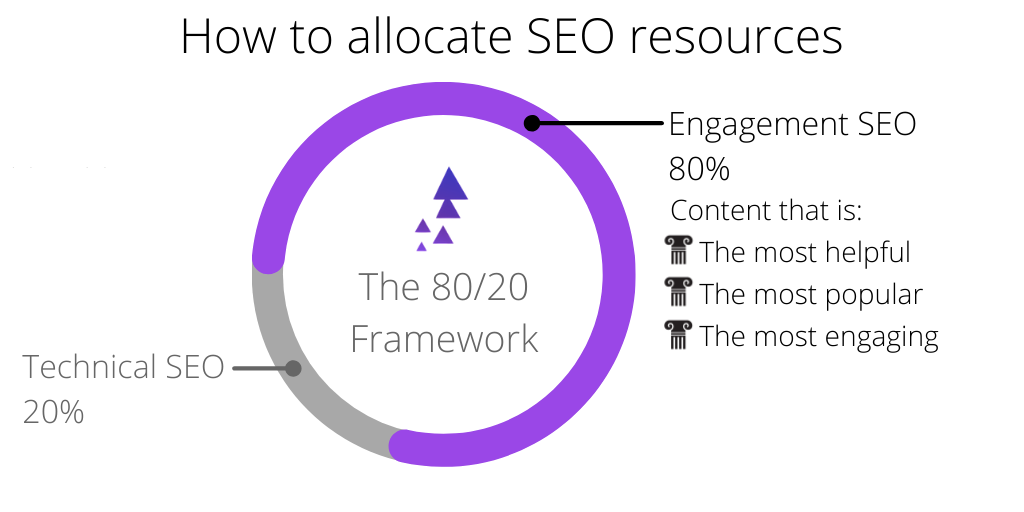B2B SEO: 4 Straight-Forward Steps to Getting Started
The most important resource for B2B decision makers researching purchase decisions is search engines. In fact, more than 80% of B2B purchase cycles start with a web search.
That makes SEO (“search engine optimization”) a crucial marketing strategy for any B2B business that wants to stay competitive in the digital landscape.
As more and more B2B brands realize that they can’t avoid SEO anymore, the space is quickly crowding. Add to that the rapid pace of change in the evolution of search engines—and, thus, in SEO best-practices—and it can be difficult for a B2B marketer to know where to begin or how to get started with SEO.
The good news is that it’s not too late to jump in. An updated perspective and a modern framework for how to focus and prioritize your SEO efforts, can start improving brand awareness and online conversions faster than you might think.
1. Update Your Perspective on B2B SEO
A modern, revenue-driven SEO campaign is an unbeatable opportunity for B2B businesses to get in front of their target audiences.
Ready for an update? Don’t miss these 7 B2B SEO best practices. →
Too many B2B marketers consider SEO as nothing more than a strategy for driving traffic to the website. Good SEO will do that, but when we broaden our gaze to consider the entire market, it becomes clear that SEO is one of the most effective strategies for meeting buyers who are actively searching for your products and/or solutions.
Whether or not each specific account represented by each unique click is new to your sales funnel is not the point. The point is, you know this audience.
Your sales team, customer service representatives, marketers, product managers, etc., know how to talk to this audience. They understand the buyer’s pain points and struggles, and they can probably predict which questions those buyers are going to ask.
SEO captures, organizes, and presents that information in a way that will engage decision-makers who are searching. And they are searching.
2. Understand and Apply User Intent
Keyword traffic volume, by itself, is meaningless.  [Click to Tweet]
[Click to Tweet]
If you don’t understand why buyers are typing those terms into Google, or what they hope to find, your team will never be able to engage them. In the same way that you conduct market research, develop buyer personas, and/or develop account insights for your ABM campaigns, user intent research helps you learn about your audience so you can create an effective strategy.
For example, if you are a logistics provider, one of your target keywords might be “omnichannel fulfillment,” but what question are buyers really asking when they type those words into a search engine? Does he want to purchase services? Does he want the latest strategy? Maybe he just wants a simple definition of the term.
The best way to find out, as with so many other things, is to Google it (use a depersonalized search, though). Here is a sample of the Page 1 results:

Of the first seven organic results, only one (Saddle Creek Logistics) is a branded page selling omnichannel services. The rest are offering news and definitions, which means that kind of information is, primarily, what users want to find when they search that term. (Google has machine learning robots updating their algorithms 24/7/365, so there’s hardly a better authority for this kind of insight.)
With user intent insight in hand, your content marketing team can get to work producing material that answers buyers’ questions better than the competition. Study the pages that are currently ranking, but don’t just mimic: improve. Consider what they are doing well, and what you can improve. How can you be:
- Clearer?
- More helpful?
- More practical?
- More shareable?
- More interactive?
- More mobile-friendly?
The best content online is what drives value for businesses.
3. Clean Up Technical SEO Issues and then Walk Away
Technical SEO considerations—things like image alt text, clean code and URLs, XML sitemaps, etc.—are important because they get you on the playing field, but they do not drive competitive SEO today. If your marketing team was a football team (don’t laugh), technical SEO would be their cleats and helmets, etc. They’ll need those things to play, but good gear doesn’t win games.
At Profound Strategy, we allocate our resources according to what we call, “The 80/20 Framework.”

That means, yes, only 20% of your time should be spent on technical considerations. Make sure your XML sitemap has been submitted to Google, fix any penalties that might be outstanding, improve mobile-friendliness and site speed, and then walk away.
Seriously: Walk. Away.

It might feel like this, but I promise: it’s okay.
Because there will almost always be technical SEO busywork to do, but once you have the red flags taken care of, the technical factors will not get you on Page 1 for keywords that convert. They do have a positive SEO value, but if it detracts from your engagement SEO work and improving your user experience, it’s not worth it.
4. User Experience: The #1 SEO Ranking Factor
SEOs want to make search engines happy, but search engines just want to make users happy—because happy users drive the price of Google Ad spots on their SERPs. So once the technical emergencies have been addressed, take a fresh look at your existing website and at some engagement metrics on Google Analytics, to answer three questions:
- Are your SEO visitors happy? You will know if your SEO visitors are happy based on engagement metrics like bounce rates, conversions, time-on-site, clicks, etc. If non-branded search traffic visitors (represented in Analytics where the keyword is “not provided”) stick around and engage with your site, then they’re interested in your content. If not, it’s time to start asking why not.
- How does your website and content compare to the competition? Comparing your site to the competition is largely subjective. You can look at rankings in general—who is outranking whom for key industry search terms—but it’s not a litmus test. Scroll through competitors’ pages and posts, and decide what they are doing better than you are. Then, up the ante.
- How does your site look? The visual appeal of a site often seems trivial to executives—especially in a lot of B2B industries—but visual presentation can pose an SEO problem. A lot of B2B brands have dark, outdated websites, and they are driving buyers away. Mobile usability is often times even worse.
We like to say that content marketing needs SEO because even the best content won’t convert if no one can find it. In the same way, SEO needs design, because even the best SEO won’t convert if the user gets overwhelmed (or offended) by bad design and bounces out of the site as fast as the Back button will load.
Next Steps
Whether your B2B business is just getting started with SEO, or you’re cleaning up a mess, take it one step at a time:
- Complete some user intent research. If you have a long list of keywords, start with the top 10, and figure out what your audience really wants when they Google those terms. This is the beginning of your content marketing strategy. Make sure you have landing pages that answer those questions.
- Document FAQs from your sales and support teams. What questions or comments (or complaints) do they hear and answer over and over again? Add those to your content marketing strategy list. Short answers can be collected on an FAQ page, and longer answers can get their own landing pages.
- Do a technical audit of your site and make sure there are no serious technical concerns holding you back. Once you are free of penalties and easily crawlable, get back to content creation.
- Study your engagement metrics. Benchmarking and bounce rates will help you identify which content is working, so you can experiment to figure out why. Does your audience prefer infographics or video? Which titles or types of content work better at the top of the funnel vs the bottom?
Test, tweak, improve, and repeat.
SEO is a constantly evolving strategy, so do your best to stay on top of search engine updates and industry trends. In the meantime, remember that Google’s end goal is to deliver the very best content to users, based on the search terms they use. If you stay focused on the same goal, it will be hard to make an enemy of the search giant.
What's Next?
Profound Strategy is on a mission to help growth-minded marketers turn SEO back into a source of predictable, reliable, scalable business results.
Start winning in organic search and turn SEO into your most efficient marketing channel. Subscribe to updates and join the 6,000+ marketing executives and founders that are changing the way they do SEO:
And dig deeper with some of our best content, such as The CMO’s Guide to Modern SEO, Technical SEO: A Decision Maker’s Guide, and A Modern Framework for SEO Work that Matters.




